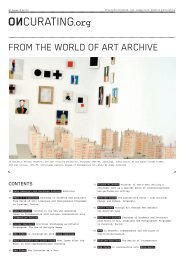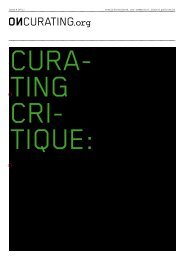Create successful ePaper yourself
Turn your PDF publications into a flip-book with our unique Google optimized e-Paper software.
051 Issue # 11/11 : PublIc Issues<br />
sPatial Practices<br />
of oda Projesi<br />
and the<br />
Production of<br />
sPace in istanbul<br />
Derya Özkan<br />
In 1997, Özge Açıkkol, Güne¸s Sava¸s, and Seçil Yersel, three<br />
women artists who met <strong>as</strong> graduate students at Marmara Uni-<br />
versity Fine Art Academy (Istanbul), rented a ground floor<br />
apartment in one of the buildings surrounding the Italian<br />
Courtyard in Galata. Initially, they intended to use<br />
the apartment <strong>as</strong> a shared artists' studio. Born into urban<br />
middlecl<strong>as</strong>s families and having grown up in Istanbul, the<br />
three women, by then in their early to mid 20s, and who<br />
would later initiate the art collective Oda Projesi 1 , were<br />
in search of a space that would allow them to dissociate<br />
themselves from their parental homes and to work in a re-<br />
latively independent environment. Diverging from the atti-<br />
tudes of most of their fellow artists moving into Galata<br />
in the 1990s, Özge, Güne¸s, and Seçil started to commu-<br />
nicate with their low-income neighbors living around the<br />
Italian Courtyard, which physically facilitated face-toface<br />
encounters. 2 The first encounters were with local<br />
children, who began to pay frequent visits to their artist<br />
neighbors' apartment to join them painting or chatting.<br />
Next came the women of the neighborhood, who felt<br />
comfortable enough to share their daily lives with the<br />
artists. Acquaintances developed and the studio gradually<br />
transformed into a gathering place for the children and<br />
women living around the courtyard. In 2000, the three<br />
women artists gave themselves the group-name Oda Projesi,<br />
deciding to operate <strong>as</strong> an art collective and to further<br />
explore the possibilities arising from their lived<br />
experiences in Galata.<br />
The motivation for initiating the art collective lay in<br />
questions around how to make art in relation to and with<br />
an awareness of their immediate urban surroundings. In<br />
other words, for Oda Projesi members, deciding to form an<br />
art collective meant deciding to explore how art could<br />
not only be inspired by but also become a material response<br />
to urban social life in Istanbul. Defining Oda Projesi <strong>as</strong><br />
an art project proposition or an initiative in search<br />
of new ways of art-making, Özge, Güne¸s, and Seçil describe<br />
their work <strong>as</strong> "an everyday life performance both shaping<br />
and being shaped by relationships between people and<br />
spaces" (Interview, 24 April 2006; Oda Projesi Archives<br />
2005). Asked about what is at the b<strong>as</strong>is of their work,<br />
Seçil defines their initial motivations in the following<br />
way:<br />
"Oda Projesi is so much related to Istanbul in<br />
many different senses. First of all, we take<br />
inspiration from the spatial relationships that<br />
form the city of Istanbul. [This is about] a<br />
creative way of thinking about how spaces function.<br />
(...) We are making a direct appropriation of<br />
the ways in which this city functions, by using<br />
1<br />
Oda means room in<br />
Turkish. A literal<br />
translation of Oda<br />
Projesi would be<br />
"The room project".<br />
For more infor-<br />
mation on the art<br />
collective, see<br />
the Oda Projesi<br />
website: (www.<br />
odaprojesi.org).<br />
This website<br />
is currently under<br />
maintenance<br />
(accessed in March<br />
2011), but the<br />
Turkish contents<br />
of the website are<br />
accessible at<br />
http://www.oda<br />
projesi.blogspot.<br />
com.<br />
2<br />
I use the artists'<br />
first names for two<br />
re<strong>as</strong>ons. First,<br />
the works that the<br />
art collective<br />
produces in Galata<br />
have a live qua-<br />
lity and they rely<br />
greatly on face-<br />
to-face relation-<br />
ships, where<br />
artists and neigh-<br />
bors know each<br />
other often only<br />
by first names.<br />
Also, and b<strong>as</strong>ed on<br />
the foregoing, my<br />
analysis of Oda<br />
Projesi's work h<strong>as</strong><br />
an ethnographic<br />
dimension and this<br />
makes my personal<br />
relationship to<br />
them indispensable<br />
from my research.<br />
the existing potentials of the spaces in which we<br />
live together with other people. (...) You can<br />
e<strong>as</strong>ily see that there are always interventions in<br />
urban space in Istanbul, small or big touches...<br />
Everybody touches the city and in a way makes it<br />
his/her own (Interview, 31 May 2005)."<br />
Becoming aquainted with everyday life in and around the<br />
courtyard and exploring the city from 1997 to 2000, Özge,<br />
Güne¸s, and Seçil recognized the prevalence of the inhabitants'<br />
interventions in urban space in Istanbul and the<br />
roles such interventions play in the social production<br />
of space in the neighborhood they were actually part of.<br />
Motivated by the complex spatial constellations produced<br />
via the inhabitants' interventions, and taking them <strong>as</strong><br />
their model, Oda Projesi started to realize art projects<br />
in Galata. In their own words, "the constantly changing<br />
courtyard, the multiple uses of penthouses, the make-<br />
shift ladder used <strong>as</strong> a shortcut from the courtyard to the<br />
apartments on upper floors, the kitchens extended into<br />
balconies in relatively small apartments, the laundry dry-<br />
ing rope stretched between windows" are some of the habits,<br />
practices, or situations Oda Projesi members consider <strong>as</strong><br />
models which they borrow from everyday life in the neighborhood<br />
(Interview, 24 April 2006).<br />
Oda Projesi experiments with these models in various art<br />
projects that could be grouped in numerous ways. Filtered<br />
through my perspective that highlights their involvement<br />
with space and urban spatial practices, a major group<br />
is what I call situational works in Galata. The situational<br />
works functioned almost like a catalyst for Oda Projesi<br />
in its process of becoming an art collective; and the art<br />
collective continues using the artistic strategies developed<br />
in Galata in projects realized elsewhere. The situa-<br />
tional works interweave several strategies: the first<br />
strategy is to make use of already available socio-spatial<br />
situations in the neighborhood, interact with them, learn<br />
from them, and develop a response to them. The second in-<br />
volves creating situations by bringing to the Italian<br />
Courtyard people, ide<strong>as</strong>, and practices which are normally<br />
foreign to the neighbors – although they are readily avail-<br />
able within walking distance around Tünel. This strategy<br />
w<strong>as</strong> deployed to create collaborative artworks or realize<br />
various events (such <strong>as</strong> a book reading, a shadow play<br />
show, an experimental music workshop) that took place either<br />
in the apartment, in the courtyard, or elsewhere in its<br />
close vicinity. All these works are necessarily sitespecific<br />
and require corporeal involvement. They animate<br />
social spaces and create spatial situations, in search of<br />
innovative forms of artistic representation.


![Download as PDF [10.6 MB]](https://img.yumpu.com/4266533/51/500x640/download-as-pdf-106-mb.jpg)

